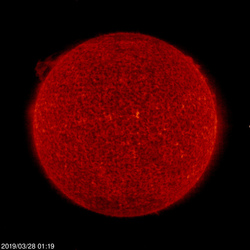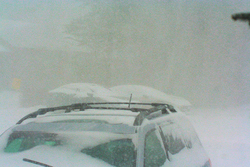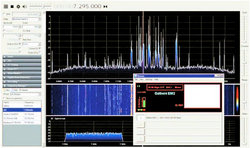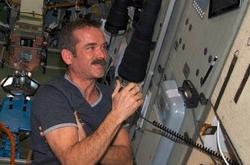 March 28, 2019 John E. Ross, KD8IDJ, Editor
| ||||||
Modified Digital QST App Now Available for Apple iOS Users Apple has released a new app for digital QST (version 5.1) for digital readers that use iOS devices. A long-standing problem involved the inability of some Apple iOS app users to download digital QST issues to their devices. When they attempted to do so, the app crashed. The new app is now available on the Apple iTunes store. Apple also required ARRL to create a new version of the app that allows non-members to purchase individual issues of the QST digital edition.
The updated app will be a so-called "in-app purchase" version, which Apple requires ARRL and other publishers to use. "You might think of it as an electronic newsstand. It will allow non-members to purchase single issues of QST for $6.99," Ford said. Android and Kindle users and those who view digital QST on desktop or laptop computers will not be affected by this change. Android and Kindle users do not need to update their apps. Colorado ARES Volunteers Muster for "Bomb Cyclone" Winter Storm Amateur Radio Emergency Service® (ARES®) volunteers in Colorado stepped up as a mid-month "bomb cyclone" winter storm struck the state, with heavy rain shifting to heavy snowfall. The storm affected several states and led to significant flooding in Nebraska. Parts of Colorado recorded winds of nearly 100 MPH and record-low barometric pressure readings. ARES teams in Colorado began preparations a day ahead of the so-called "bombogenesis" weather event.
Pikes Peak ARES alerted its personnel via email and a regularly scheduled Tuesday net and coordinated with the Special Communications Unit (SCU), a special cadre of radio amateurs in the Pikes Peak Regional Office of Emergency Management (OEM). Most SCU members also belong to ARES, but when called up by the OEM, they wear their SCU hats. The SCU planned to deploy to the Emergency Coordination Center (ECC) on March 12 and be ready to operate first thing in the morning. At the time, the Red Cross did not anticipate needing Pikes Peak ARES support, so the ARES district planned to undertake weather spotting for the National Weather Service (NWS) office in Pueblo and relay status information to the ECC. By the morning of March 13, however, the storm's timing had changed, and the Red Cross requested ARES operators in four shelters, creating a problem with recruiting and deploying sufficient volunteers in time. Three ARES At the request of NWS Pueblo, a formal weather net was called up and ran for more than 10 hours, even though the primary and back-up net control stations lost power for several hours. Some 70 operators provided reports during the storm and its aftermath. An informal net continued for another 16 hours until the SCU operators were released from the ECC. "While the net started out as a weather net, it quickly became a common way for operators to report stranded motorists, requests for assistance, abandoned vehicles, Good Samaritan rescues -- important so that the ECC could clear police, fire, rescue, and National Guard units from responding -- shelter status, and requests about road conditions," said John Bloodgood, KD0SFY, Pikes Peak ARES Emergency Coordinator and Public Information Officer (PIO). The storm stranded more than 1,000 motorists in El Paso County. Neighboring Douglas and Elbert counties also took proactive measures on March 12, opening emergency operations centers (EOCs) in anticipation of the storm. Both counties count on ARES of Douglas and Elbert Counties (ARESDEC) radio to support communication in emergencies. Before the heavy rain turned to snow, the two counties had already begun to open shelters. The ARES team's operations staff closely followed weather forecasts and knew this activation would be different.
"Our preferred procedure is to keep our operational periods to about 8 hours," ARESDEC Operations Chief Denny Phillips, W0DDP, explained. "However, we knew that once our people were in place, especially on the eastern plains, that providing relief would not be possible. Our people would have ride out the storm in the shelters." As the storm progressed, it became clear to county officials that additional shelters would be needed. ARESDEC operators assisted the Red Cross in setting up shelters and organizing and managing food service. By the end of the storm, more than 1,100 people were hosted in eight shelters across the two counties. ARESDEC deployed 17 radio operators. Emergency Coordinator Jim Rooney, N4JJR, praised the volunteers' performance, saying, "Our team performed well above expectations due to their commitment to training and willingness to serve." Colorado Section Emergency Coordinator Robert Wareham, N0ESQ, oversaw and took part in the overall response. -- Thanks to Pikes Peak ARES EC and PIO John Bloodgood, KD0SFY, and ARESDEC PIO Ron Coffee, KD0TRY The Doctor Will See You Now! "WSPR" is the topic of the new (March 28) episode of the "ARRL The Doctor is In" podcast. Listen...and learn!
Every 2 weeks, your host, QST Editor-in-Chief Steve Ford, WB8IMY, and the Doctor himself, Joel Hallas, W1ZR, will discuss a broad range of technical topics. You can also email your questions to doctor@arrl.org, and the Doctor may answer them in a future podcast. Enjoy "ARRL The Doctor is In" on Apple iTunes, or by using your iPhone or iPad podcast app (just search for "ARRL The Doctor is In"). You can also listen online at Blubrry, or at Stitcher (free registration required, or browse the site as a guest) and through the free Stitcher app for iOS, Kindle, or Android devices. If you've never listened to a podcast before, download our beginner's guide. Just Ahead in Radiosport
See the ARRL Contest Calendar for more information. For in-depth reporting on Amateur Radio contesting, subscribe to The ARRL Contest Update via your ARRL member profile email preferences. The K7RA Solar Update Tad Cook, K7RA, Seattle, reports: During the March 21 - 27 reporting week, solar activity increased while geomagnetic indicators were lower, compared to the previous 7 days. This is a nice combination for the first week of spring. Although sunspots and solar flux decreased toward the end of the period, average daily sunspot numbers doubled from 8 to 16, and average daily solar flux increased from 70.7 to 75.2. Average daily planetary A index decreased from 8.1 to 3.7, and average daily middle latitude A index decreased from 6.3 to 3.9.
The planetary A index is a composite from magnetometers around the globe, but the middle latitude A index is from a single magnetometer in Virginia. Predicted solar flux from the March 27 forecast is 68 on March 28 - April 3; 70 on April 4 - 6; 71 and 74 on April 7 - 8; 75 on April 9 - 18; 74, 73, 73, and 71 on April 19 - 22; 70 on April 23 - May 3; 71 and 74 on May 4 - 5, and 75 on May 6 - 11. Predicted planetary A index is 18, 12, 8, and 5 on March 28 - 31; 8 on April 1 - 3; 5 on April 4 - 11; 15 and 10 on April 12 - 13; 5 on April 14 - 21; 8, 12, 12, 8, and 8 on April 22 - 26; 5 on April 27 - 28; 8 on April 29 - 30; 5 on May 1 - 8, and 12, 8, and 5 on May 9 - 11. There were no sunspots on March 26 - 27. Sunspot group AR2736 appeared on March 23, then disappeared. Sunspot numbers for March 21 - 27 were 49, 27, 22, 14, 0, 0, and 0, with a mean of 16. The 10.7-centimeter flux was 80.1, 82.4, 79.4, 75.4, 71.2, 69, and 68.9, with a mean of 75.2. Estimated planetary A indices were 2, 1, 1, 3, 5, 6, and 8, with a mean of 3.7. Middle latitude A index was 2, 2, 2, 3, 5, 5, and 8, with a mean of 3.9. A comprehensive K7RA Solar Update is posted Fridays on the ARRL website. For more information concerning radio propagation, visit the ARRL Technical Information Service, read "What the Numbers Mean...," and check out K9LA's Propagation Page. A propagation bulletin archive is available. Monthly charts offer propagation projections between the US and a dozen DX locations. Share your reports and observations. 3Y0I Bouvet Island DXpedition "Postponed, Not Canceled" The 3Y0I DXpedition to Bouvet Island (Bouvetøya) is off, at least for now. The skipper of the MV Atlantic Tuna determined it was not safe to continue its voyage to the remote Antarctic island after the vessel "The captain of the MV Atlantic Tuna had to [m]ake a difficult but responsible decision to take a course back to Cape Town, South Africa," a March 27 news release said. "But the 3Y0I Expedition is not cancelled -- we don't give up that easily." The DXpedition's press officer, Stan Strzyzewski, SP8S, said he'd had a "long conversation" with DXpedition leader Dom Grzyb, 3Z9DX, who reported that the seas had calmed enough to permit crew members to inspect damage caused by a "severe cyclonic storm" on March 26 when the vessel was some 70 nautical miles off Bouvet Island. The ship was hit by waves of more than 36 feet and winds exceeding 100 MPH.
"The fierce oceanic forces swept past the upper deck, taking one of the radars, including VSAT, VHF, and HF marine antennas, off the mast and throwing them all overboard," Strzyzewski recounted. He stressed that all members of the DXpedition team are "fine, feeling OK, and safe." "With lack of the most important navigational tools, the captain declared it's not safe to navigate and they need to go back to Cape Town to secure all participants on board, their equipment, and the vessel's gear," Strzyzewski continued. "In addition, all forecasts for coming hours are not positive." Once back in Cape Town, the team will reassess its plans and decide whether to attempt a return voyage to Bouvet in April or to postpone the DXpedition for next season. In February 2018, unfavorable weather and a mechanical failure on the transport vessel caused the cancellation of the 3Y0Z Bouvet Island DXpedition, after the team had arrived just offshore. Ohio ARES Provides "Situational Awareness" During January Blizzard Ohio ARES members stared down "Snowmageddon" 2019, the mid-January blizzard that blanketed the lower Great Lakes region. Based on ominous forecasts and discussion with Assistant Section Emergency Coordinators (SECs) across the state, Section Manager Scott Yonally, N8SY, and the Ohio Watch Office, SEC Stan Broadway, N8BHL, asked ARES operators to provide observations and reports to assist decision makers at the Ohio Emergency Operations Center and county emergency management agency centers.
A statewide net was convened on Saturday, January 9, as conditions deteriorated. Amateurs quickly began checking in and reporting their local conditions with specific details. The reports were compiled by Ohio's AuxComm Team station W8SGT, which was operated from Broadway's residence on 80 meters, and the VHF/UHF Digital Mobile Radio (DMR) network (the Ohio Talk group), simultaneously. By nightfall, storm conditions had stabilized, and reporting slowed to the point that the statewide net could be closed. Many county-level nets were also in operation.
Broadway said emergency managers around the state were impressed that Amateur Radio could furnish reports with such detailed information. He said HF capability to reach across the state was a proven asset, with effective communication in all directions. "Winter storms are part of the Ohio landscape, and we don't propose ramping up a net for every snowfall," Broadway said. "But when the forecasts call for extreme conditions, ARES operators have now proven we can be a true asset for our served partner agencies. Read more. -- Ohio Section Emergency Coordinator Stan Broadway, N8BHL Whither Digital Radio Mondiale? In a recent issue of QST, Steve Ford, WB8IMY, took a look at the forgotten Digital Radio Mondiale (DRM) system. Digital broadcasting was supposed to be the life preserver for international shortwave broadcasters facing the reality of rising costs and shrinking audiences. In 1998, broadcasters, equipment manufacturers, regulators, and others formed the DRM consortium to create a specification for digital shortwave broadcasting that might stem the growing shift to internet broadcasting and revive listener interest. DRM promised an FM-quality signal that also could convey text information such as program titles and news headlines. DRM signals heard on a conventional AM receiver sound like wide-band noise. The DRM signal carries three separate channels -- a primary audio channel, and two subsidiary channels, one for essential decoding data and a third service description channel. Unfortunately, Some international HF broadcasters still use DRM on a regular basis. The list includes the BBC, Radio France International, and All India Radio. Decoding a DRM signal is far easier today than it was a decade or so ago, and the rise of software-defined radio (SDR) has provided new avenues for DRM listening. Many SDRs specifically include DRM as a reception mode. Radio amateurs early on experimented on HF using DRM-derived software called WinDRM. Much has changed over the intervening years, and today the HF digital voice application of choice is FreeDV. If you hear buzzing signals at 14.236 MHz, chances are it's a FreeDV QSO. For more information on this topic, see "Eclectic Technology" in the April 2019 issue of QST (p. 65). Smithsonian Institution's NN3SI Returning to the Air The historic NN3SI call sign is being reactivated under the aegis of the Smithsonian Institution Amateur Radio Group. "We do not have a physical station location, and we are not open for guest operation as in the past, but this this is the start to Amateur Radio slowly coming back at the Smithsonian," the group's president, John Weise, N4NPG, told ARRL. "We expect to begin operating holiday-style starting in April."
NN3SI will operate mobile and portable from several District of Columbia, Virginia, and Maryland locations on most bands and modes. NN3SI hopes to be on the air for most contests this year including Rookie Roundup, the ARRL June VHF Contest, and ARRL Field Day, Weise added. As he recounts, NN3SI was initially a temporary "special" call sign granted to the Smithsonian during the US bicentennial in 1976, and the station remained active until 2008 when building renovations left NN3SI without a permanent location. "The call sign lapsed, but was renewed this year," Weise said, "and the new Smithsonian Institution Amateur Radio Group has been organized as a club for Smithsonian staff members, and to provide important emergency management and STEM educational resources to the Smithsonian Institution." -- Thanks to John Weise, N4NPG ARISS Seeks Hosts for Ham Radio Contacts with Space Station Crew Members Starting on April 1, Amateur Radio on the International Space Station (ARISS) will accept applications from US schools, museums, science centers, and community youth organizations (working individually or together) interested in hosting contacts with orbiting crew members on the International Space Station (ISS). Contacts will be scheduled between January 1 and June 30, 2020. Each year, ARISS provides tens of thousands of students with opportunities to learn about space technologies and communications through Amateur Radio. The program provides learning opportunities by connecting students to astronauts aboard the ISS through a partnership between ARRL, AMSAT, and NASA, as well as other Amateur Radio organizations and worldwide space agencies. The program's goal is to inspire students to pursue interests and careers in science, technology, engineering, and mathematics (STEM) and Amateur Radio.
ARISS says enthusiasm sparked by a school contact has led to an interest in ham radio among students and to the creation of ham radio clubs in schools. Some educators have even become radio amateurs after experiencing a contact with an ISS crew member. ARISS is looking for organizations capable of attracting large numbers of participants and integrating the contact into a well-developed, exciting education plan. Students can learn about satellite communications, wireless technology, science research conducted on the ISS, radio science, and any related STEM subject. Students learn to use Amateur Radio to talk directly to an astronaut and ask their STEM-related questions. ARISS will help educational organizations locate Amateur Radio groups who can assist. The deadline to submit proposals is May 15. Proposal webinars for guidance and questions will be offered on April 11 at 7 PM EDT (2300 UTC) and on April 16 at 9 PM EDT (0100 UTC on Wednesday, April 17). Advance registration is required. More details, such as expectations, proposal guidelines, and the proposal form, are on the ARISS website. Flaw Could Permit Hacking of Implanted Devices Medtronic, the world's largest medical device company, has acknowledged that many of its implanted cardiac defibrillators use an unencrypted wireless protocol that could let an attacker change the device settings. The Department of Homeland Security's Cybersecurity and Infrastructure Security Agency (CISA) has assigned the flaw a vulnerability score of 9.3 -- near the top of its 10-point scale. It said the flaw makes it possible for an unauthorized party to read and write any memory location of the implanted devices. At issue is the Conexus radio frequency telemetry protocol, which is used as part of its remote patient-management system for communicating between defibrillators, home monitoring devices, and clinician programming devices. According to CISA, affected devices include the MyCareLink Monitor, CareLink Monitor, CareLink 2090 Programmer, and other Medtronic implanted cardiac devices listed in its alert. The primary vulnerabilities are improper access control and transmission of sensitive information.
The CISA alert goes on to say, "Medtronic has applied additional controls for monitoring and responding to improper use of the Conexus telemetry protocol by the affected implanted cardiac devices. Additional mitigations are being developed and will be deployed through future updates, assuming regulatory approval. Medtronic recommends that users take additional defensive measures to minimize the risk of exploitation of these vulnerabilities." These "additional defensive measures" are spelled out in the CISA alert. The US Food and Drug Administration has also issued an alert. -- Thanks to Department of Homeland Security's Cybersecurity and Infrastructure Security Agency Upcoming ARRL Section, State, and Division Conventions
Find conventions and hamfests in your area. See the ARRL Contest Calendar for more information. For in-depth reporting on Amateur Radio contesting, subscribe to The ARRL Contest Update via your ARRL member profile email preferences.
. .
Subscribe to...
Free of charge to ARRL members...
| ||||||
 "Members must update their digital QST apps for the changes to take effect," QST Editor Steve Ford, WB8IMY, explained. "This entails tapping the App Store icon, and then tapping Updates from the store menu. They may have to log in after the update, but should not have to log in after that."
"Members must update their digital QST apps for the changes to take effect," QST Editor Steve Ford, WB8IMY, explained. "This entails tapping the App Store icon, and then tapping Updates from the store menu. They may have to log in after the update, but should not have to log in after that.".JPG)
.jpg) volunteers were identified, but by then the weather was so severe that only one was able to get through, amid difficulties.
volunteers were identified, but by then the weather was so severe that only one was able to get through, amid difficulties.-2.jpg)
 Sponsored by
Sponsored by  These numbers are all good, because higher sunspot numbers and solar flux suggest better enhancement of the ionosphere, while the lower geomagnetic numbers correspond to generally lower absorption or disturbed conditions.
These numbers are all good, because higher sunspot numbers and solar flux suggest better enhancement of the ionosphere, while the lower geomagnetic numbers correspond to generally lower absorption or disturbed conditions. suffered some damage from severe storm conditions. The DXpedition had expected to arrive on the island on March 26 and be on the air by month's end.
suffered some damage from severe storm conditions. The DXpedition had expected to arrive on the island on March 26 and be on the air by month's end..JPG)
 "We could do this safely from our homes, and integrate our reports (remotely) into the state's
"We could do this safely from our homes, and integrate our reports (remotely) into the state's  The Ohio "Snow Net" received 131 reports from 44 of Ohio's 88 counties, split evenly between HF and DMR. The short-notice net was entered into the ARES Connect system and more than 50 amateurs signed up for the net event. Several other local snow nets entered for county events also. The statewide reports were logged and submitted every few hours to the state Homeland Security/Emergency Management Agency Watch Desk through WebEOC.
The Ohio "Snow Net" received 131 reports from 44 of Ohio's 88 counties, split evenly between HF and DMR. The short-notice net was entered into the ARES Connect system and more than 50 amateurs signed up for the net event. Several other local snow nets entered for county events also. The statewide reports were logged and submitted every few hours to the state Homeland Security/Emergency Management Agency Watch Desk through WebEOC. DRM failed to halt the decline of shortwave broadcasting; it was too little, too late. In addition, consumer electronics manufacturers lacked enthusiasm for the new format, so an audience for DRM never coalesced.
DRM failed to halt the decline of shortwave broadcasting; it was too little, too late. In addition, consumer electronics manufacturers lacked enthusiasm for the new format, so an audience for DRM never coalesced..jpg)

 "Successful exploitation of these vulnerabilities may allow an attacker with adjacent short-range access to one of the affected products to interfere with, generate, modify, or intercept the radio frequency (RF) communication of the Medtronic proprietary Conexus telemetry system, potentially impacting product functionality and/or allowing access to transmitted sensitive data," CISA said. "The result of successful exploitation of these vulnerabilities may include the ability to read and write any valid memory location on the affected implanted device and therefore impact the intended function of the device."
"Successful exploitation of these vulnerabilities may allow an attacker with adjacent short-range access to one of the affected products to interfere with, generate, modify, or intercept the radio frequency (RF) communication of the Medtronic proprietary Conexus telemetry system, potentially impacting product functionality and/or allowing access to transmitted sensitive data," CISA said. "The result of successful exploitation of these vulnerabilities may include the ability to read and write any valid memory location on the affected implanted device and therefore impact the intended function of the device."







